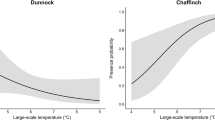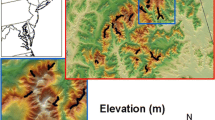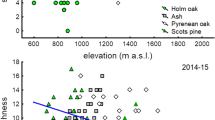Abstract
Many species have shown recent shifts in their distributions in response to climate change. Patterns in species occurrence or abundance along altitudinal gradients often serve as the basis for detecting such changes and assessing future sensitivity. Quantifying the distribution of species along altitudinal gradients acts as a fundamental basis for future studies on environmental change impacts, but in order for models of altitudinal distribution to have wide applicability, it is necessary to know the extent to which altitudinal trends in occurrence are consistent across geographically separated areas. This was assessed by fitting models of bird species occurrence across altitudinal gradients in relation to habitat and climate variables in two geographically separated alpine regions, Piedmont and Trentino. The ten species studied showed non-random altitudinal distributions which in most cases were consistent across regions in terms of pattern. Trends in relation to altitude and differences between regions could be explained mostly by habitat or a combination of habitat and climate variables. Variation partitioning showed that most variation explained by the models was attributable to habitat, or habitat and climate together, rather than climate alone or geographic region. The shape and position of the altitudinal distribution curve is important as it can be related to vulnerability where the available space is limited, i.e. where mountains are not of sufficient altitude for expansion. This study therefore suggests that incorporating habitat and climate variables should be sufficient to construct models with high transferability for many alpine species.



Similar content being viewed by others
References
Araújo MB, Rahbek C (2006) How does climate change affect biodiversity? Science 313:1396–1397
Bartoń K (2013) MuMIn: Multi-model inference. R package version 1.9.0 ed
Bates D, Maechler M, Bolker B, Walker S (2015) Fitting linear mixed-effects models using lme4. J Stat Softw 67:1–48
Bellard C, Bertelsmeier C, Leadley P, Thuiller W, Courchamp F (2012) Impacts of climate change on the future of biodiversity. Ecol Lett 15:365–377
Bibby CJ, Burgess ND, Hill DA, Mustoe SH (2000) Bird census techniques, 2nd edn. Academic, London
Bradbury RB, Pearce-Higgins JW, Wotton S, Conway GJ, Grice PV (2011) The influence of climate and topography in patterns of territory establishment in a range-expanding bird. Ibis 153:336–344
Brambilla M, Bergero V, Bassi E, Falco R (2015) Current and future effectiveness of Natura 2000 network in the central Alps for the conservation of mountain forest owl species in a warming climate. Eur J Wildl Res 61:35–44
Braunisch V, Coppes J, Arlettaz R, Suchant R, Zellweger F, Bollmann K (2014) Temperate mountain forest biodiversity under climate change: compensating negative effects by increasing structural complexity. PLoS ONE 9:e97718
Cannone N, Sgorbati S, Guglielmin M (2007) Unexpected impacts of climate change on alpine vegetation. Front Ecol Environ 5:360–364
Caprio E, Chamberlain DE, Isaia M, Rolando A (2011) Landscape changes caused by high altitude ski-spites affect bird species richness and distribution in the Alps. Biol Conserv 144:2958–2967
Chamberlain D, Arlettaz R, Caprio E, Maggini R, Pedrini P, Rolando A, Zbinden N (2012) The altitudinal frontier in avian climate change research. Ibis 154:205–209
Chamberlain DE, Negro M, Caprio E, Rolando A (2013) Assessing the sensitivity of alpine birds to potential future changes in habitat and climate to inform management strategies. Biol Conserv 167:127–135
Chamberlain DE, Negro M, Caprio E, Rolando A (2014) Shifting habitats in the Alps and potential future consequences for birds. In: Proceedings of the BOU’s 2014 annual conference, ecology and conservation of birds in upland and alpine habitats. Published Online http://www.bou.org.uk/bouproc-net/uplands/chamberlain-etal.pdf
Chamberlain DE, Pedrini P, Brambilla M, Rolando A, Girardello M (2016) Identifying key conservation threats to Alpine birds through expert knowledge. Peer J 4:e1723
Chen I-C, Hill JK, Ohlemüller R, Roy DB, Thomas CD (2011) Rapid range shifts of species associated with high levels of climate warming. Science 333:1024–1026
Crawley MJ (2013) The R book, 2nd edn. Wiley, Chichester
Dirnböck T, Essl F, Babitsch W (2011) Disproportional risk for habitat loss of high-altitude endemic species under climate change. Glob Change Biol 17:990–996
EEA (2010) Europe’s ecological backbone: recognising the true value of our mountains. EEA Report 6/2010. European Environment Agency, Copenhagen
Farmer RG, Leonard ML, Flemming JEM, Andersen SC (2014) Observer aging and long-term avian survey data quality. Ecol Evol 4:2563–2576
Ficetola GF, Thuiller W, Miaud C (2007) Prediction and validation of the potential global distribution of a problematic alien species—the American bullfrog. Divers Distrib 13:476–485
Flousek J, Telensky T, Hanzelka J, Reif J (2015) Population trends of Central European montane birds provide evidence for adverse impacts of climate change on high-altitude species. PLoS ONE 10:e0139465
Freeeman E (2007) PresenceAbsence: an R package for presence-absence model evaluation. USDA Forest Service, Ogden
Gifford ME, Kozak KH (2012) Islands in the sky or squeezed at the top? Ecological causes of elevational range limits in montane salamanders. Ecography 35:193–203
Guisan A, Thuiller W (2005) Predicting species distribution: offering more than simple habitat models? Ecol Lett 8:993–1009
Harsch MA, Hulme PE, McGlone MS, Duncan RP (2009) Are treelines advancing? A global meta-analysis of treeline response to climate warming. Ecol Lett 12:1040–1049
Hijmans RJ, Cameron SE, Parra JL, Jones PG, Jarvis A (2005) Very high resolution interpolated climate surfaces for global land areas. Int J Climatol 25:1965–1978
Hodkinson ID (2005) Terrestrial insects along elevational gradients: species and community responses to altitude. Biol Rev 80:489–513
Huntley B, Green RE, Collingham YC, Willis SG (2007) A climatic atlas of European breeding birds. Lynx, Barcelona
Jetz W, Wilcove DS, Dobson AP (2007) Projected impacts of climate and land-use change on the global diversity of birds. PLoS Biol 6:e157
Laiolo P, Dondero F, Ciliento E, Rolando A (2004) Consequences of pastoral abandonment for the structure and diversity of the alpine avifauna. J Appl Ecol 41:294–304
Legendre P (2008) Studying beta diversity: ecological variation partitioning by multiple regression and canonical analysis. J Plant Ecol 1:3–8
Lehikoinen A, Green M, Husby M, Kålås JE, Lindström Å (2014) Common montane birds are declining in Northern Europe. J Avian Biol 45:3–14
Lenoir J, Gégout JC, Marquet PA, de Ruffray P, Brisse H (2008) A significant upward shift in plant species optimum elevation during the 20th century. Science 320:1768–1771
Maggini R, Lehmann A, Kéry M, Schmid H, Beniston M, Jenni L, Zbinden N (2011) Are Swiss birds tracking climate change? Detecting elevational shifts using response curve shapes. Ecol Model 222:21–32
Maggini R, Lehman A, Zbinden N, Zimmerman NE, Bollinger J, Schröder B, Foppen R, Schmid H, Beniston M, Jenni L (2014) Assessing species vulnerability to climate and land use change: the case of the Swiss breeding birds. Divers Distrib 20:708–719
Melendez L, Laiolo P (2014) The role of climate in constraining the elevational range of the Water Pipit Anthus spinoletta in an alpine environment. Ibis 156:276–287
Moritz C, Agudo R (2013) The future of species under climate change: resilience or decline? Science 341:504–508
Moritz C, Patton JL, Conroy CJ, Parra JL, White GC, Beissinger SR (2008) Impact of a century of climate change on small-mammal communities in Yosemite National Park, USA. Science 322:261–264
Nagakawa S, Schiezeth H (2013) A geneal and simple method for obtaining R 2 from generalized linear mixed-effects models. Methods Ecol Evol 4:133–142
Parmesan C, Yohe G (2003) A globally coherent fingerprint of climate change impacts across natural systems. Nature 421:37–42
Pernollet CA, Korner-Nievergelt F, Jenni L (2015) Regional changes in elevational distribution of the Alpine Rock Ptarmigan Lagopus muta helvetica in Switzerland. Ibis 157:823–836
R Development Core Team (2013) R: A Language and Environment for Statistical Computing 3.01. R Foundation for Statistical Computing, Vienna
Rahbek C (2005) The role of spatial scale and the perception of large-scale species-richness patterns. Ecol Lett 8:224–239
Randin CF, Dirnböck T, Dullinger S, Zimmermann NE, Zappa M, Guisan A (2006) Are niche-based species distribution models transferable in space? J Biogeogr 33:1689–1703
Randin CF, Engler R, Normand S, Zappa M, Zimmermann NE, Pearman PB, Vittoz P, Thuiller W, Guisan A (2009) Climate change and plant distribution: local models predict high-elevation persistence. Glob Change Biol 15:1557–1569
Reif J, Flousek J (2012) The role of species’ ecological traits in climatically driven altitudinal range shifts of central European birds. Oikos 121:1053–1060
Rolando A, Caprio E, Rinaldi E, Ellena I (2007) The impact of high-altitude ski-runs on alpine grassland bird communities. J Appl Ecol 44:210–219
Sala OE, Chapin FS, Armesto JJ, Berlow E, Bloomfield J, Dirzo R, Huber-Sanwald E, Huenneke LF, Jackson RB, Kinzig A, Leemans R, Lodge DM, Mooney HA, Oesterhel M, Poff NL, Sykes MT, Walker BH, Walker M, Wall DH (2000) Global biodiversity scenarios for the year 2100. Science 287:1770–1774
Sauer JR, Peterjohn BG, Link WA (1994) Observer differences in the North American Breeding Bird Survey. Auk 111:50–62
Schaub M, Kéry M, Birrer S, Rudin M, Jenni L (2011) Habitat-density associations are not geographically transferable in Swiss farmland birds. Ecography 34:693–704
Sekercioglu CH, Schneider SH, Fay JP, Loarie SR (2008) Climate change, elevational range shifts and bird extinctions. Conserv Biol 22:140–150
Shoo LP, Williams SE, Hero J-M (2006) Detecting climate change induced range shifts: where and how should we be looking? Aust Ecol 31:22–29
Swets JA (1988) Measuring the accuracy of diagnostic systems. Science 240:1285–1293
Tryjanowski P, Sparks TH, Profuc P (2005) Uphill shifts in the distribution of the white stork Ciconia ciconia in southern Poland: the importance of nest quality. Divers Distrib 11:219–223
Walther GR, Post E, Convey P, Menzel A, Parmesan C, Beebee TJ, Fromentin JM, Hoegh-Guldberg O, Bairlein F (2002) Ecological responses to recent climate change. Nature 416:389–395
Whittingham MJ, Krebs JR, Swetnan RD, Vickery JA, Wilson JD, Freckleton RP (2007) Should conservation strategies consider spatial generality? Farmland birds show regional not national patterns of habitat association. Ecol Lett 10:25–35
Wilson RJ, Gutiérrez D, Gutiérrez J, Martinez D, Agudo R, Monserrat VJ (2005) Changes to the elevational limits and extent of species ranges associated with climate change. Ecol Lett 8:1138–1146
Zuur AF, Ieno EN, Walker NJ, Saveliev AA, Smith GM (2009) Mixed effects models and extensions in ecology with R. Springer, New York
Acknowledgments
The research in Piedmont was partly funded through a Grant to DEC from the People Programme (Marie Curie Actions) of the European Union’s Seventh Framework Programme FP7/2007–2013/. The research in Trentino was partially supported by Accordo di programma PAT, 2010–2013 and MUSE 2011–2012; we are grateful to Franco Rizzolli and Francesco Ceresa for field work in Trentino. We are grateful to Ola Olsson and an anonymous referee for their constructive comments on an earlier version of the manuscript.
Author contribution statement
All authors contributed significantly to the conception and planning of the paper. DEC took a lead in analysing the data and writing the paper. MB and EC carried out data extraction in GIS. PP and AR managed fieldwork in Trentino and Piedmont, respectively.
Author information
Authors and Affiliations
Corresponding author
Additional information
Communicated by Ola Olsson.
Electronic supplementary material
Below is the link to the electronic supplementary material.
Rights and permissions
About this article
Cite this article
Chamberlain, D., Brambilla, M., Caprio, E. et al. Alpine bird distributions along elevation gradients: the consistency of climate and habitat effects across geographic regions. Oecologia 181, 1139–1150 (2016). https://doi.org/10.1007/s00442-016-3637-y
Received:
Accepted:
Published:
Issue Date:
DOI: https://doi.org/10.1007/s00442-016-3637-y




